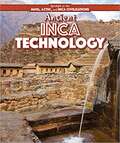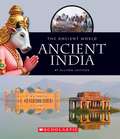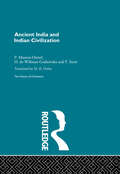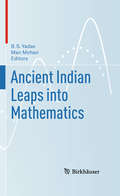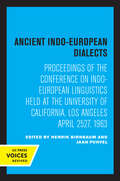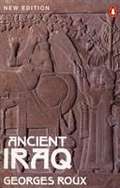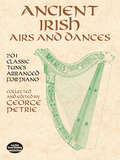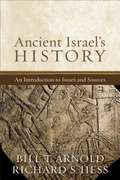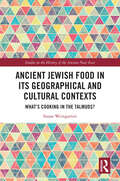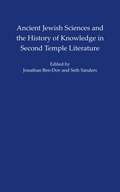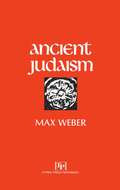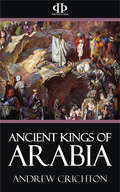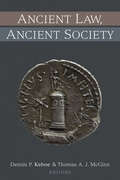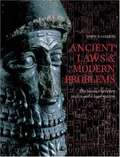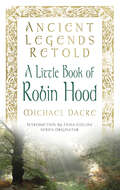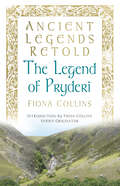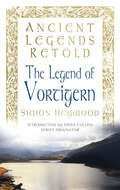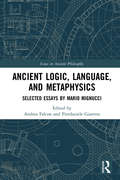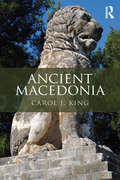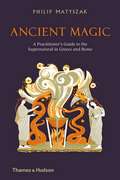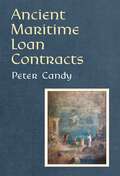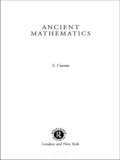- Table View
- List View
Ancient Inca Technology (Spotlight on the Maya, Aztec, and Inca Civilizations)
by Ryan NagelhoutThe Inca Empire was a complex, highly developed society that ruled ancient Peru for centuries. The civilization grew strong thanks to important advances in technology. This information-rich title covers the Inca’s roads and communications systems, buildings, bridges, terrace farming, and tools. Readers will also learn about important scientific innovations such as calendars, Quipu, the Incas’ understanding of astronomy, and their medicinal practices. Written with age-appropriate language and accompanied by colorful images, this title brings Inca technology to life.
Ancient India (The Ancient World)
by Allison LassieurAn engaging text that examines the culture and history of ancient India.
Ancient India and Indian Civilization (The\history Of Civilization Ser.)
by P. Masson-Ousel P. Stern H. Willman-GrabowskaOriginally published between 1920-70,The History of Civilization was a landmark in early twentieth century publishing. It was published at a formative time within the social sciences, and during a period of decisive historical discovery. The aim of the general editor, C.K. Ogden, was to summarize the most up to date findings and theories of historians, anthropologists, archaeologists and sociologists. This reprinted material is available as a set, in the following groupings, or as individual volumes: * Prehistory and Historical Ethnography Set of 12: 0-415-15611-4: £800.00 * Greek Civilization Set of 7: 0-415-15612-2: £450.00 * Roman Civilization Set of 6: 0-415-15613-0: £400.00 * Eastern Civilizations Set of 10: 0-415-15614-9: £650.00 * Judaeo-Christian Civilization Set of 4: 0-415-15615-7: £250.00 * European Civilization Set of 11: 0-415-15616-5: £700.00
Ancient Indian History: 7000 BCE to Islamic Settlement
by Rohit MajumdarA concise and engaging textbook that studies the history of ancient India, from 7000 BCE up to the beginning of the Islamic settlement in the subcontinent. This textbook introduces, in a unique manner, the history and development of the Indian subcontinent through categorical evidence, data and critical assessment of contemporary global happenings. Ancient Indian History offers multiple parallels to students to aid them in visualizing India as a vessel of cultures. It brings together archaeology, social anthropology, war philosophies, war politics, numismatic evidence, countless modern discoveries and research evidence. This book bases itself on the premise that globalization is not a phenomenon that was initiated in India in the 1990s but something that has existed in this subcontinent for the last 7000 years or more. The book will prove to be a valuable companion for UG students of history as well as UGC NET and civil service aspirants who want a comprehensive yet compact introduction to the history of ancient India. Key Features: • Incorporates the latest archaeological findings and filters inferences in an accessible manner • Written in a narrative style, avoiding overflow of data • Provides comparative study of contemporary global movements and their effects on Indian history • Has a holistic approach, covering perspectives from across India, unlike other contemporary texts
Ancient Indian Leaps into Mathematics
by B. S. Yadav Man MohanThis book presents contributions of mathematicians covering topics from ancient India, placing them in the broader context of the history of mathematics. Although the translations of some Sanskrit mathematical texts are available in the literature, Indian contributions are rarely presented in major Western historical works. Yet some of the well-known and universally-accepted discoveries from India, including the concept of zero and the decimal representation of numbers, have made lasting contributions to the foundation of modern mathematics. Through a systematic approach, this book examines these ancient mathematical ideas that were spread throughout India, China, the Islamic world, and Western Europe.
Ancient Indian Politics and Culture up to 1206 AD: பழங்கால இந்தியா அரசியலும் பண்பாடும் கி.பி. 1206 வரை
by Dr Pon Thangamaniஇந்நூலில் தமிழக வரலாற்றிற்குச் சிறப்பான இடம் தரப்பட்டுள்ளது. அரசியல் வரலாறும் பண்பாட்டு வரலாறும் தனித்தனியே பிரித்து அளிக்கப்பட்டுள்ளன. சாதாரண மனிதனின் அன்றாட வாழ்க்கையைக் குறிக்கும் பண்பாடு தெளிவாக விளக்கப்பட்டுள்ளது. காலவரையறை, வரலாற்றிற்கு முதுகெலும்பு என்பதை உணர்ந்து அதன் அடிப்படையில் பாடங்கள் இணைக்கப் பட்டுள்ளன. கருத்து வேறுபாடுகள் நிலவிவரும் குறிப்பிட்ட செய்திகளுக்கு நடுநிலையில் நின்று தீர்வுகாண முயலப்பட்டுள்ளது. இந்நூல் இந்திய வரலாற்றைப் பயிலும் பட்டப்படிப்பு மாணவ மாணவிகளுக்கும், பொதுவாக இந்திய வரலாற்றை அறிய விழையும் வாசகர்களுக்கும் பயன்படும் வகையில் எழுதப்பட்டுள்ளது
Ancient Indo-European Dialects: Proceedings of the Conference on Indo-European Linguistics Held at the University of California, Los Angeles April 25–27, 1963
by Jaan Puhvel Henrik BirnbaumThe first book to provide a rigorous and comprehensive view of the linguistic divisions of early Europe, Asia Minor, Northern India, and Chinese Turkestan. The unifying topic "Ancient Indo-European Dialects" was chosen with a view to utilizing to best advantage the many competences of the contributors int eh extinct languages and language groups of early Europe, the Near East, and Central Asia. In this book each specialist treats the subdivision particularly suited to his research interest, yet is always conscious of and conversant with the entire sweep and continuity oft he Indo-European language area. It is an effort at delimiting the historically and methodologically demonstrable subgroupings, including a critique of such time-worn combination as Italo-Celtic and Balto-Slavic, and incorporating the principles of modern dialectology in a diachronic application. This title is part of UC Press's Voices Revived program, which commemorates University of California Press's mission to seek out and cultivate the brightest minds and give them voice, reach, and impact. Drawing on a backlist dating to 1893, Voices Revived makes high-quality, peer-reviewed scholarship accessible once again using print-on-demand technology. This title was originally published in 1966.
Ancient Iraq
by Georges RouxBook provides an introduction to the history of ancient Mesopotamia and its civilizations, incorporating archaeological and historical finds up to 1992.
Ancient Irish Airs and Dances: 201 Classic Tunes Arranged for Piano
by George PetrieFrom the tender "My heart's love is he" to the bitter "Hag, you've killed me," this extraordinary compilation of melodies ranks among the most important 19th-century collections of traditional Irish music. Out of print for many years, these selections have become extremely rare and sought-after items.
Ancient Israel's History: An Introduction To Issues And Sources
by Bill T. Arnold Richard S. HessThe history of Israel is a much-debated topic in Old Testament studies. On one side are minimalists who find little of historical value in the Hebrew Bible. On the other side are those who assume the biblical text is a precise historical record. Many serious students of the Bible find themselves between these two positions and would benefit from a careful exploration of issues in Israelite history. This substantive history of Israel textbook values the Bible's historical contribution without overlooking critical issues and challenges. Featuring the latest scholarship, the book introduces students to the current state of research on issues relevant to the study of ancient Israel. The editors and contributors, all top biblical scholars and historians, discuss historical evidence in a readable manner, using both canonical and chronological lenses to explore Israelite history. Illustrative items, such as maps and images, visually support the book's content. Tables and sidebars are also included.
Ancient Israelites and Their Neighbors: An Activity Guide (Cultures Of The Ancient World Ser.)
by Marian BroidaChildren can try their hand at re-creating ancient Israelite culture--along with the cultures of their neighbors, the Philistines and Phoenicians--in a way that will provide perspective on current events. The book covers a key period from the Israelites' settlement in Canaan in 1200 B.C.E. to their return from exile in Babylonia in 538 B.C.E. This part of the Middle East--no larger than modern-day Michigan--was the birthplace of Judaism, Christianity, and Islam. More than 35 projects include stomping grapes into juice, building a model Phoenician trading ship, making a Philistine headdress, and writing on a broken clay pot. Israelites', Phoenicians', and Philistines' writing and languages, the way they built their homes, the food they ate, the clothes they wore, and the work they did, and of course, their many interesting stories, are all explored.
Ancient Jewish Food in Its Geographical and Cultural Contexts: What's Cooking in the Talmuds? (Studies in the History of the Ancient Near East)
by Susan WeingartenThis book is the first in-depth study of food in talmudic literature in its geographical and cultural contexts. It demonstrates the sharing of foods and foodways between Jews and their non-Jewish neighbours in the Near East in Late Antiquity.Using both ancient written sources and archaeological evidence, this book sets the foods of the Mishnah and Palestinian Talmud in their Graeco-Roman context, and the foods of the Babylonian Talmud and the ge’onim in their Persian and Arab contexts. It explores practices of food preparation and their contribution to the ancient diet, as well as analysing the relationships between food, status and culture. The rabbinical authors of talmudic literature were more concerned with everyday food than were aristocratic Classical authors; by examining both talmudic sources and archaeological finds, this book paints a new picture of the diet, lifestyle and culture of ordinary people.Ancient Jewish Food in Its Geographical and Cultural Contexts will interest Food Historians as well as students and scholars of Jewish Studies, particularly the period of the Mishnah and Talmud, as well as those dealing with the wider social and cultural history of the Ancient Near East.
Ancient Jewish Sciences and the History of Knowledge in Second Temple Literature (ISAW Monographs #3)
by Seth L. SandersUntil very recently, the idea of ancient Jewish sciences would have been considered unacceptable. Since the 1990s, Early Modern and Medieval Science in Jewish sources has been actively studied, but the consensus was that no real scientific themes could be found in earlier Judaism. This work points them out in detail and posits a new field of research: the scientific activity evident in the Dead Sea Scrolls and early Jewish pseudepigrapha. The publication of new texts and new analyses of older ones reveals crucial elements that are best illuminated by the history of science, and may have interesting consequences for it. The contributors evaluate these texts in relation to astronomy, astrology, and physiognomy, marking the first comprehensive attempt to accountfor scientific themes in Second Temple Judaism. They investigate the meaning and purpose of scientific explorations in an apocalyptic setting. An appreciation of these topics paves the way to a renewed understanding of the scientific fragments scattered throughout rabbinic literature.The book first places the Jewish material in the ancient context of the Near Eastern and Hellenistic worlds. While the Jewish texts were not on the cutting edge of scientific discovery, they find a meaningful place in the history of science, between Babylonia and Egypt, in the time period between Hipparchus and Ptolemy. Thebook uses recent advances in method to examine the contacts and networks of Jewish scholars in their ancient setting. Second, the essays here tackle the problematic concept of a national scientific tradition. Although science is nowadays often conceived as universal, the historiography of ancient Jewish sciences demonstratesthe importance of seeing the development of science in a local context. The book explores the tension between the hegemony of central scientific traditions and local scientific enterprises, showing the relevance of ancient data to contemporary postcolonial historiography of science. Finally, philosophical questions of the demarcation of science are addressed in a way that can advance the discussion of related ancient materials.Online edition available as part of the NYU Library's Ancient World Digital Library and in partnership with the Institute for the Study of the Ancient World (ISAW).
Ancient Judaism
by Max WeberWeber’s classic study which deals specifically with: Types of Asceticism and the Significance of Ancient Judaism, History and Social Organization of Ancient Palestine, Political Organization and Religious Ideas in the Time of the Confederacy and the Early Kings, Political Decline, Religious Conflict and Biblical Prophecy.
Ancient Kings of Arabia
by Andrew CrichtonThe history of Arabia naturally divides itself into three periods, the Ancient, the Military, and the Modern. The first carries us down to the age of Mohammed, and is called by the Arabs the Times of Ignorance. The second includes the wars of the Saracens, and the empire of the caliphs. The third embraces the events from the fall of the caliphate to the present day. The native writers who treat of the first period all flourished, as has been observed, posterior to the era of the Prophet. It may seem remarkable that, among an intellectual and opulent people, no historians should have appeared to commemorate the events of their own times; but the causes are to be ascribed chiefly to their national character and habits.
Ancient Law, Ancient Society
by Dennis P. Kehoe Thomas McginnThe essays composing Ancient Law, Ancient Society examine the law in classical antiquity both as a product of the society in which it developed and as one of the most important forces shaping that society. Contributors to this volume consider the law via innovative methodological approaches and theoretical perspectives—in particular, those drawn from the new institutional economics and the intersection of law and economics. Essays cover topics such as using collective sanctions to enforce legal norms; the Greek elite’s marriage strategies for amassing financial resources essential for a public career; defenses against murder charges under Athenian criminal law, particularly in cases where the victim put his own life in peril; the interplay between Roman law and provincial institutions in regulating water rights; the Severan-age Greek author Aelian’s notions of justice and their influence on late-classical Roman jurisprudence; Roman jurists’ approach to the contract of mandate in balancing the changing needs of society against respect for upper-class concepts of duty and reciprocity; whether the Roman legal authorities developed the law exclusively to serve the Roman elite’s interests or to meet the needs of the Roman Empire’s broader population as well; and an analysis of the Senatus Consultum Claudianum in the Code of Justinian demonstrating how the late Roman government adapted classical law to address marriage between free women and men classified as coloni bound to their land. In addition to volume editors Dennis P. Kehoe and Thomas A. J. McGinn, contributors include Adriaan Lanni, Michael Leese, David Phillips, Cynthia Bannon, Lauren Caldwell, Charles Pazdernik, and Clifford Ando.
Ancient Laws and Modern Problems: The Balance Between Justice and a Legal System
by John SassoonThe author’s study of the written laws of four thousand years ago puts paid to the belief that the most ancient laws were merely arbitrary and tyrannical. On the contrary, the earliest legal systems honestly tried to get to the truth, do justice to individuals, and preserve civil order. They used the death penalty surprisingly seldom, and then more because society had been threatened than an individual killed. Some of the surviving law codes are originals, others near-contemporary copies. Together they preserve a partial but vivid picture of life in the early cites. This occupies more than half the book. Comparison of ancient with modern principles occupies the remainder and is bound to be controversial; but it is important as well as fascinating. The first act of writing laws diminished the discretion of the judges and foretold a limit on individual justice. Some political principles such as uniformity of treatment or individual freedom have, when carried to extremes, produced crises in modern legal systems world wide. But it is tempting but wrong to blame the judges or the lawyers for doing what society require of them.
Ancient Legends Retold: A Little Book of Robin Hood (Ancient Legends Retold)
by Fiona Collins Michael DacreThis collection of five tales and one play contains the definitive Robin Hood. They are the earliest ballads and play and still the best of the bunch. ‘Robin Hood and the Monk’ is the earliest surviving manuscript, dated c.1450, and is considered the greatest of the ballads, though it was probably not sung, being described as a ‘talkyng’; ‘Robin Hood’s Death’ is one of the most satisfying tragedies in the English language; while ‘A Lytell Geste of Robyn Hode’ is a comprehensive account of the famous English outlaw - complete, unified and pointing quite clearly to the reign of Edward II as a probable time for an historical Robin Hood, despite the opinions of most of the experts.
Ancient Legends Retold: The Legend of Pryderi (Ancient Legends Retold)
by Fiona CollinsThe Four Branches of the Mabinogion are a rich treasure trove of tales. These magical, quintessentially Welsh stories are confusing, but it would be hard to match their splendid strangeness. The Four Branches tell of the kings and queens of Wales in the time of’ ‘Once upon a time’. Only one character appears in all Four Branches. He is Pryderi, and the story of his life journey is told in this book. Pryderi is brave and bold: sometimes foolhardy, always fiercely loyal. The stories of two beautiful, powerful women entwine with his: Rhiannon of the Birds, his mother, and Cigfa, his wife. Both accompany him on his life path. But, at the last, Pryderi must go on alone. Here, for the first time, his tale is told from beginning to end.
Ancient Legends Retold: The Legend of Vortigern (Ancient Legends Retold)
by Fiona Collins Simon Heywood'My name is Vortigern ... ' Generations before Arthur's birth, a British warlord looks back on his life: his rise from humble roots to shake the thrones of a dying empire; his stand against chaos amid the aftermath of Rome; his struggle with the greedy, embittered princes of church and kingdom; his loves and his losses, and his last encounter with his own mysterious destiny, on a mountain where the world we know is beginning to take shape before his eyes. Vortigern's voice speaks from the heart of a forgotten darkness, telling a story of courage and cowardice, glory and crime, tragedy and treason.
Ancient Logic, Language, and Metaphysics: Selected Essays by Mario Mignucci (Issues in Ancient Philosophy)
by Andrea Falcon Pierdaniele GiarettaThe late Mario Mignucci was one of the most authoritative, original, and influential scholars in the area of ancient philosophy, especially ancient logic. Collected here for the first time are sixteen of his most important essays on Ancient Logic, Language, and Metaphysics. These essays show a perceptive historian and a skillful logician philosophically engaged with issues that are still at the very heart of history and philosophy of logic, such as the nature of predication, identity, and modality. As well as essays found in disparate publications, often not easily available online, the volume includes an article on Plato and the relatives translated into English for the first time and an unpublished paper on De interpretatione 7. Mignucci thinks rigorously and writes clearly. He brings the deep knowledge of a scholar and the precision of a logician to bear on some of the trickiest topics in ancient philosophy. This collection deserves the close attention of anyone concerned with logic, language, and metaphysics, whether in ancient or contemporary philosophy.
Ancient Macedonia
by Carol J. KingThe first English-language monograph on ancient Macedonia in almost thirty years, Carol J. King's book provides a detailed narrative account of the rise and fall of Macedonian power in the Balkan Peninsula and the Aegean region during the five-hundred-year period of the Macedonian monarchy from the seventh to the second century BCE. King draws largely on ancient literary sources for her account, citing both contemporary and later classical authors. Material evidence from the fields of archaeology, epigraphy, and numismatics is also explored. Ancient Macedonia balances historical evidence with interpretations—those of the author as well as other historians—and encourages the reader to engage closely with the source material and the historical questions that material often raises. This volume will be of great interest to both under- and post-graduate students, and those looking to understand the fundamentals of the period.
Ancient Magic: A Practitioner's Guide To The Supernatural In Greece And Rome
by Philip MatyszakAn accessible historical exploration of the methods and motivations behind using magic in ancient Greece and Rome. In the ancient world, magic was everywhere. The supernatural abounded, turning flowers into fruit and caterpillars into butterflies. In a time before scientists studied weather patterns and figured out what caused the Earth’s most mysterious phenomena, it was magic that packed a cloud full of energy until it exploded with thunderbolts. It was everyday magic, but it was still magical. In Ancient Magic, author Philip Matyszak ushers readers into that world, showing how ancient Greeks and Romans concocted love potions and cast curses, how they talked to the dead and protected themselves from evil spirits. He takes readers to a world where gods interacted with humans and where people could not only talk to spirits and deities, but could themselves become divine. Ancient Magic presents us with a new understanding of the role of magic, combining a classical historiography with a practical how-to guide. Using a wide array of sources and lavish illustrations, this book offers an engaging and accessible way into the supernatural for all.
Ancient Maritime Loan Contracts (Law And Society In The Ancient World)
by Peter CandyAncient Maritime Loan Contracts studies the first millennium of the standard form contracts at the heart of ancient long-distance trade, from the fifth century BCE to Justinian. Maritime loan contracts recorded the terms of agreement on which a creditor lent a sum of money to a merchant or carrier to finance the purchase of a cargo for a trading expedition overseas. They were the lifeblood of the long-distance trade in bulk commodities that flourished in the Mediterranean and Black Seas and were also among the first private agreements to be fully committed to writing. From at least the fifth century BCE, these contracts were highly standardized in their terms, containing boilerplate clauses in a tried-and-tested construction. Maritime loan contracts continued to be used to finance maritime trade until the late Middle Ages, when they were only finally superseded by the contract of marine insurance. Combining a wide variety of papyrological, epigraphic, and legal evidence, Peter Candy’s framework illustrates the significance of these contracts in both their economic and legal context. By using an interdisciplinary approach, Ancient Maritime Loan Contracts addresses important questions about how maritime trade was financed in the context of the ancient economy; the response of individual legal cultures to maritime loan contracts; and the relationship between international commercial practice and legal development in the ancient world.
Ancient Mathematics (Sciences of Antiquity)
by Serafina CuomoThe theorem of Pythagoras, Euclid's "Elements", Archimedes' method to find the volume of a sphere: all parts of the invaluable legacy of ancient mathematics. But ancient mathematics was also about counting and measuring, surveying land and attributing mystical significance to the number six. This volume offers the first accessible survey of the discipline in all its variety and diversity of practices. The period covered ranges from the fifth century BC to the sixth century AD, with the focus on the Mediterranean region. Topics include:* mathematics and politics in classical Greece* the formation of mathematical traditions* the self-image of mathematicians in the Graeco-Roman period* mathematics and Christianity* and the use of the mathematical past in late antiquity.
